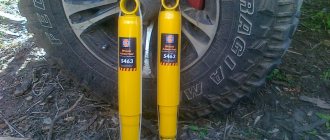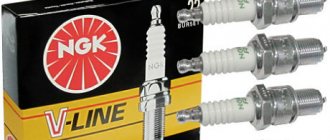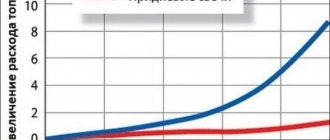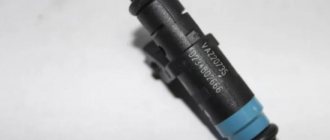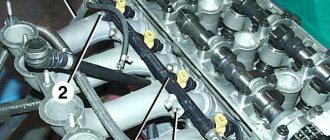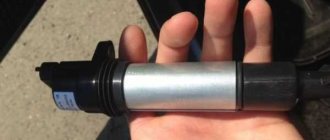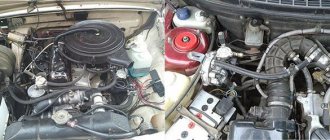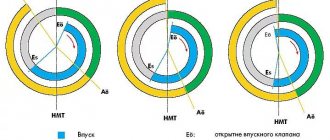Taking into account the constantly rising prices for fuel, the installation of gas equipment in some cases becomes a completely justified and rational decision. The gradual improvement of gas equipment has made it possible to create complex products suitable for various types of gasoline engines. It is worth noting that the LPG kits that are available for free sale are often sets of various elements that were produced by different manufacturers. In other words, the components of LPG are not the finished product of only one company. This approach allows you to flexibly change prices, interchange individual components taking into account quality, etc.
We also recommend reading the article about what HBO is. From this article you will learn about different generations of gas equipment (I, II, III, etc.), how gas equipment differs from one generation to another, design features and operating principles.
One of the most frequently discussed components of such equipment are gas injectors. The fact is that the performance of a gas engine directly depends on the quality and efficiency of their work. Let us add that these elements from different manufacturers differ somewhat in a number of parameters. In this article we will talk about what features gas injectors have, as well as which injectors are best installed on gas equipment.
4th generation HBO injectors: operating principle and features
Let's start with the fact that, in their design, gas injection parts have much in common with gasoline injectors. It should be noted that there are also individual developments with serious differences from most analogues, but such products are quite rare. At the same time, general similarity in design does not mean that gasoline and gas injectors are similar in their operating parameters.
The fact is that after evaporation in the gearbox, 250 times more gas is supplied to the injectors compared to the same amount of gasoline. This means that the gas injector has a much larger cross-section of passage holes to improve throughput. It should also be noted that gas injectors differ from gasoline injectors in reduced electrical resistance (from 1 to 3 Ohms for gas injectors versus 16 or 17 Ohms for gasoline injectors). The need to reduce resistance is dictated by the fact that the element needs to pass a much larger volume of fuel compared to a gasoline injector.
For this reason, the control of gas injectors is implemented differently. If a gasoline injector opens by applying a 12 V electrical pulse to it, then applying a similar pulse to a gas injector will damage the element. Low winding resistance will lead to the fact that the part will simply burn out with a 12V pulse.
To solve the problem, the opening of the gas injector is realized using a special method (pulse width modulation). In simple words, an initial impulse is applied to the element, which leads to an opening, but then the impulse is interrupted and occurs again. Such an interruption is carried out at high speed, that is, the nozzle does not have time to close, and its winding does not overheat.
BRC
Manufacturer's website www.brc.it
At one time, the company completed its kits with “Pan Evo” nozzles from the Italian company Zavoli. Thanks to this, it was possible to significantly reduce the cost of the kit. Due to the design features of Pan Evo injectors, they require servicing every 10,000 km. Now BRC engineers are working on refining Zavoli injectors and increasing their service life. BRC injectors are maintenance-free, like gasoline injectors.
Therefore, since 2011, Sequent 24 MY 11 kits have gone on sale. These are practically the same Sequent 24 MY10, but the injectors and injector rack are from BRC, and the injectors are improved. Thanks to the axial, rather than radial arrangement of the holes, and a different implementation of the seal and fastening, it was possible to reduce the overall dimensions of the injectors. The main parameter - the opening/closing time of the injectors - for Pan-Evo is 3.5 ms, for BRC - 2.0 - 1.6 ms. That is, these nozzles, according to the manufacturer, are among the fastest and most accurate!
Advantages
- Great working injectors!
Flaws
- They are too picky about the quality of gas, so they only require original filters and timely replacement!
Basic parameters when choosing gas injectors
The use of gas injectors eliminates the need for atomizers, since the gas is supplied to the nozzle already evaporated. It turns out that all you need is a fitting that will be installed in the intake manifold. The installation location is the area next to the gasoline injector.
As mentioned above, the LPG injector has a number of parameters that affect the stability of the internal combustion engine, power, gas consumption, etc. The main parameter is considered to be the linearity with which the injectors operate. For example, opening a nozzle for 3 milliseconds means that during this time a strictly defined amount of gas will pass through the device. Moreover, if the element is opened for 6 milliseconds, then the volume of gas passed through should double. But these are ideal conditions, which is rare in practice, especially when using affordable mass solutions. In other words, cheap injectors do not have linear performance. As a result, there is a significant overconsumption of gas, a gas engine loses power, operates unstably, the temperature regime of the internal combustion engine is disrupted, etc. As a result, problems arise with the catalyst, valves burn out and a number of other malfunctions appear.
We also recommend reading the article about what pros and cons appear after installing LPG. From this article you will learn about the main advantages and disadvantages of using gas equipment in a car, and also decide whether to install gas in a car.
Another important operating parameter of gas injectors is considered to be the response time, that is, the reaction speed. This should be understood as the physical opening of the injector after receiving a control electrical pulse. It is quite obvious that the faster the injectors respond to the signal, the more stable and accurate the entire system operates.
Let us add that it is highly desirable that the injectors on the engine supply an equal amount of gas to each cylinder, that is, their performance is the same. In the budget segment, there are often products from the same set that have noticeable differences from each other in this indicator. Taking into account the fact that gas injectors operate under conditions of a significant temperature difference (on a cold engine this indicator can be around -20 degrees Celsius, while after warming up the indicator can exceed +100 degrees or more), the injectors must ensure stability of basic parameters in any conditions.
To put it simply, at different temperatures, the structural elements in the nozzle device change their physical dimensions when heated and cooled. The fewer changes the better. This depends on the quality of the materials used in manufacturing. As an example, consider the metering plunger of an injector. In more expensive products, metal is used for its manufacture, which has a minimal coefficient of thermal expansion.
If we consider that the stroke length of the plunger is only 0.5 mm, it becomes clear why an increase in this element under the influence of temperatures is unacceptable. If the plunger becomes longer, this will result in a reduced opening. As a result, the injector performance will decrease, engine power will disappear and consumption will increase.
Budget injectors are distinguished by the fact that the stroke of the plunger under the influence of temperature can be reduced by 15-20 percent or even more. You should also take into account the stability of maintaining operating parameters, taking into account the wear of the nozzle during operation. The fact is that the plunger is a mechanical element that is subject to natural wear during operation of the nozzle. It turns out that as wear occurs, performance may also change. A high-quality product should provide performance deterioration of no more than 5% throughout the entire design life.
Nozzle selection
Each gas equipment has its own characteristics, so it is important to select nozzles individually for each generation of gas equipment. Many motorists ask the question “Which injectors for LPG are better?” In the case of gas-cylinder equipment, this formulation is initially incorrect, because the proverb known to many applies to it: what is good for a Russian is death for a German
Naturally, the saying should be rephrased for gas equipment and understand that for one generation specific nozzles may be simply ideal, but not capable of working with another
In the case of gas-cylinder equipment, this formulation is initially incorrect, because the proverb known to many applies to it: what is good for a Russian is death for a German. Naturally, the saying should be rephrased for gas equipment and understand that for one generation specific nozzles may be simply ideal, but not able to work with another.
In order to make the right choice of injectors, it is enough to adhere to the following points:
- First, find out what generation your gas equipment is. This plays an important role in the selection process, because each type of gas equipment has its own injector standards. Thus, for the first generation the EURO safety standard is applied, for the second - EURO-2, for the third, fourth, fifth and sixth - EURO-3 and higher;
- Second, determine the number of injectors needed. It is worth noting that for HBO generations 1-3 it is permissible to purchase injectors separately. In the case of older versions of equipment, it is recommended to buy ready-made kits. This approach will help to avoid problems in further configuration of the equipment;
- Thirdly, check the connection method and other technical features of your LPG in relation to the injectors;
- And fourthly, when choosing new dispensers, give preference to trusted manufacturers. At the moment, they are deservedly considered Valtek, BRC, Digitronic, Rampa, Barracuda and Lomato. Moreover, the same BRC and Lomato produce their own gas equipment, so it is quite possible for their owners to avoid difficulties when selecting new injectors by telling the seller only the model of their equipment.
Which gas injectors are better?
There are a large number of products on the market for gas equipment components today. As for gas injectors, we can highlight products from Valtek, Hana, OMVL, Barracuda, Keihin, and Matrix. These solutions belong to the entry-level and mid-price segment, which allows them to enjoy wide popularity. Practical operation makes it possible to determine a number of advantages and disadvantages of injectors from a particular company.
- For example, the Barracuda has fairly stable performance over about 300 million cycles, which is about 250 thousand kilometers traveled.
- Also, drivers and installers of gas equipment speak well of Hana gas injectors, the service life of which is about 200 thousand km without significant loss of performance.
- More affordable Valtek ones last about 60–80 thousand kilometers traveled.
It is important to remember that, like their gasoline counterparts, gas injectors also need to be cleaned. The fact is that the gas contains a number of additional impurities, gas oil-like condensate is collected, etc. For example, the accumulation of such condensate in the cold season leads to the fact that the electromagnetic coil of some injector models is not able to tear the petal off the seat, as a result of which the injector winding burns out.
In terms of response time, Keihin can be considered the best on the list. Baraccuda also performs well, but Matrix takes quite a long time to switch off. As a result, the quality of dosing a portion of gas in the latter is significantly inferior to its competitors. Valtek is approximately on the same line with this option. Hana injectors perform a little better, which can be considered a solid, confident mid-range product. It turns out that Keihin takes the leading position, Barracuda is practically not inferior to the favorite, then comes Hana, then you can put Valtek, Matrix and OMVL on the same level. It should be added that Keihin, Barracuda and the Hana product are structurally similar to gasoline injectors, which ensures compliance with the required parameters and an acceptable service life.
Signs of malfunction
The fact that the injectors have begun to work incorrectly can be noticed by every motorist who has at least a little experience in using gas equipment. Externally, problems in their work appear as follows:
- unstable engine operation;
- no idle speed;
- lack of traction;
- increased fuel consumption;
- deterioration in engine performance, etc.
All these signs indicate that gas injectors need immediate cleaning. The reason why they become clogged may be improper maintenance of gas equipment, the use of low-quality filters for the vapor and liquid fractions of fuel, or the use of cheap liquefied gas of inadequate quality to refuel a car.
Malfunctions in the gas injection system
The LPG gas injector, if there is a malfunction in the injection system, is completely repairable. But for this you need to have a repair kit of gas injectors on hand.
Since the correct and coordinated operation of the entire LPG system is determined by the injectors, you need to learn how to diagnose their malfunctions.
It could be:
- nozzle contamination;
- imbalance of the rack;
- open circuit;
- coil short circuit;
- electronic problems.
There can be many reasons, but if you ignore them and do not react in time, you can limit yourself to not just replacing parts of the injection mechanism, but say goodbye to the entire power unit. Therefore, if in doubt what exactly the fault is, it is better to take the car to an electronic stand, where mechanics will describe the breakdown in detail.
It might end up figuring out how to clean your gas injectors, or maybe you'll need an advanced repair. But, in any case, this is more profitable from an economic point of view than replacing the entire engine.
Although the new generation of gas equipment is already equipped with systems that themselves monitor and diagnose problems. But still, if the car is retrofitted with a gas installation, inspecting the system itself is absolutely not an unnecessary manipulation. It happens that during the investigation, minor little things come to light, which, however, can lead to serious damage.
Also, when purchasing injectors, you need to read reviews of the manufacturer and compare prices for such parts, since cheap parts can cause big problems. It is best if you have any questions regarding HBO, contact the station, where specialists can advise on the operation of the HBO system.
On our website there are articles about gas injectors from companies:
- Lovato;
- Valtek;
- AEB;
- Barracuda;
- OMVL.
Do-it-yourself cleaning
Having discovered obvious signs of clogging, many car enthusiasts try to clean gas injectors themselves. The process of their cleaning consists of several stages:
- Close the supply valve located on the gas cylinder. This must be done to prevent gas from entering the engine.
- Use up all the fuel remaining in the line. When the gas runs out and the car switches to gasoline, you need to force the switch to gas several more times so that all the remaining gas is used up.
- Mark the wires going to the coil and the ramp with injectors differently. This way you will avoid any tangles in the wires when they are reinstalled. It is convenient to use electrical tape or markers of different colors for marking.
- Remove the ramp with injectors, unscrew the calibration jets.
- Remove the corkscrew rings and spool, unscrew the guides.
- Remove the rods, springs and O-rings. In this case, you must remember from which injector this or that rod is removed.
- Remove dirt and deposits from the rods, avoiding getting the rubber seals wet.
- Clean the inside of the nozzle body. A rag is best for cleaning, since using it does not leave fabric lint on the parts.
- Restore the arrangement of all parts in reverse order.
After all the injectors are returned to the ramp, all that remains is to install it in its original place and connect the wires correctly. Before using the equipment, be sure to check the system for leaks
To do this, apply a soap solution to all connections and turn on the flow valve. Bubbles will appear in places where gas will escape. These places need to be additionally fixed.
Disassembling gas injectors
The first step to removing the ramp from the car is to shut off the gas supply to the LPG line by closing the flow valve on the gas cylinder.
- Exhaust all the gas from the line; to do this, start the car with the valve closed and wait until it switches to gasoline, then force the system to switch to gas two or three more times.
- Before disconnecting the wires and removing the ramp, be sure to mark which wire belonged to which of the gas coils. This can be done using a marker or multi-colored electrical tape. When assembling, you must accurately determine whether the wire belongs to one or another coil.
- Unscrew the fasteners and remove the ramp. When unscrewing the clamps, you will hear residual gas escaping - this is a normal situation.
- Using a 12mm wrench, unscrew the calibration jets.
- Remove the corkscrew rings, carefully folding them so as not to lose them. Remove the coils. If you made marks on the coils with a marker, mark which coil was in which place so as not to confuse them during assembly. If you made marks on the ramp itself, the order of installing the coils may not be followed.
- Using a 14 key, unscrew the guides and carefully remove them. If one rod is being replaced, during disassembly, it is imperative to mark the rod-seat pair so that they are not confused during reassembly. If all parts are replaced, the order may not be followed. Remove the rods and springs from the guides.
- Conduct a visual inspection of the rods and rubber bands, determining whether you need to use a repair kit or not. If the rubber band is completely worn out, metal comes into contact with metal, resulting in a characteristic “clicking” sound.
- If the rod itself has a satisfactory appearance, you can replace only the rubber band and the spring (also in case of wear); to do this, remove the old rubber band from the rod with a sharp object (an awl) and place a new one in its place. If the mileage of the injectors is significant, the rod should also be replaced.
- Carefully inspect and replace worn parts with new ones on all injectors, then reassemble the ramp in reverse order.
It is imperative to adjust the gas injectors before installing them on the car.
Read about how to do it yourself here!
Gas injector repairs have been completed. If you have any questions during the repair process, ask them in the comments to the article and we will be happy to answer them.
I’ll briefly go through the most popular options.
Valtek Type 30. Very popular among installers, and it's easy to explain
The injectors have a simple and understandable design, can be easily repaired and are unpretentious to the quality of “our” gas, which is important. In addition, the price of such injectors is quite reasonable, so there are quite a lot of people who want to install such “forces” for themselves.
The disadvantages include low accuracy, although to a large extent everything depends on the correct calibration and configuration of the entire gas equipment. Due to their popularity, these injectors are copied by all and sundry, so “clones” of Valtek Type 30 are also found in Alex, Mimgas and Rail.
Valtek Type 34. These injectors are no less popular compared to “Type 30”, but they have more disadvantages. The first and biggest drawback is that the injectors are not repairable. The second disadvantage is that they have a short resource, so be prepared to replace them after 50 thousand km.
OMVL
The injectors from this manufacturer have much better dosage accuracy than the “bestseller” Valtek Type 30, in addition, the plastic housing allows you not to take into account temperature and use these “forces” with electronics that do not take into account the temperature of the injectors
Premium class
Barracuda. These injectors have excellent accuracy and reliability, they are not “afraid” of low-quality fuel, are resistant to contamination and are close in their characteristics to the market leader in injectors - Keihin. Another plus is that Barracuda injectors do not require calibration and have a long service life.
Keihin. Keihin injectors are rightfully considered the most accurate and temperature-independent. In addition, they work on any fuel, even the worst. The only drawback of these devices is their price. But, as you understand, you have to pay for everything...
Hana. Hana injectors are also quite good and belong more to the “premium” segment than to the mass market. Hana are an almost exact copy of Keihin injectors and have the same advantages as Keihin. The only difference is the price, it is more affordable.
Cylinders are also usually selected according to two criteria: volume and type (toroidal or cylindrical). The most important thing when choosing a cylinder is to buy original products that have all the necessary certificates and have passed all tests.
Read more about how to choose a cylinder here. I also recommend: Inspection of HBO cylinders: what is it, why and how does it happen?
The choice of gas equipment is a very important step, which should be taken no less seriously than the issue of installing this equipment. Even the most expensive and high-quality gas equipment installed with violations can cause a lot of troubles and inconveniences; in the end, you will overpay in vain, get a lot of problems and, most likely, will forever refuse to use gas as an alternative fuel. Weigh all the pros and cons, study the issue as thoroughly as possible and make your choice. If you are not sure that the selection of components will be correct, I advise you to buy a ready-made LPG kit, the components of which fit together perfectly and will not cause problems during operation. Monitor the quality and demand all the necessary certificates; there are often scammers on the market.
I have everything, write what you think about this, what in your opinion is better to buy and what do you think is the right way to choose LPG for a car
Thank you for your attention and see you again at HBOshnik. I would be extremely grateful if you repost this article on social media.
networks, there are special buttons for this below. Thank you in advance, peace and goodness to everyone! Bye
